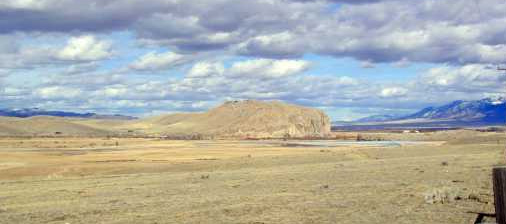Below are entries made in the journals of Lewis and Clark which substantiate the first and only written entries that without question identify Sacajawea as the member of Lemhi Shoshone tribe, which occupied the Salmon River and Bitterroot Mountain Range for over 10 thousand years.
November 4, 1804
Sacajawea and Toussaint Charbonneau are hired as interpreter and guide. Sacajawea one of Charbonneau's wives was selected because of her knowledge of the territory in which the expedition was heading toward.
 * Shoshone speaking tribes cover vast amount of territory. (From the present site of San Diego to the Commaches of North Texas throughout the present states of California, Oregon, Nevada, Utah, Wyoming, Idaho and Montana. With the Lemhi Shoshone occupying the most northern portion of this country.)
* Shoshone speaking tribes cover vast amount of territory. (From the present site of San Diego to the Commaches of North Texas throughout the present states of California, Oregon, Nevada, Utah, Wyoming, Idaho and Montana. With the Lemhi Shoshone occupying the most northern portion of this country.)
* Shoshone speaking tribes are loosely held clans and groups...similar to the pueblos of the Southwest...each tribe occupied specific territorial lands.
February 11, 1805
Sacajawea gives birth to Jean Baptiste Charbonneau, a little boy who the members of the expedition called Pompey...in the Shoshone language means hair. (American Indian children are naturally born with abundant amounts of hair.)
July 19, 1805
Captain William Clark finds the remains of several Indian camps.wicki ups that were made from willow branches, as well as pine trees that had bark peeled from them, Sacajawea informs the captains that her people used the sap and soft wood for food and medicine.
* At this point the expedition was beyond the Great Falls in Montana.
July 22, 1805
Sacajawea informs the captains that she recognizes the landmarks of people's homelands.
Just ahead are the three forks of Missouri where her people were attacked by the Mandans and the place that she was enslaved along a number of childhood friends as well as the place her mother and others were killed trying to protect the children.
* The plains tribes had acquired guns from the early fur trappers along the Missouri the Lemhi Shoshone have not encountered white people this possession of weaponry gave the advantage to the plains Indians.
July 30, 1805
Captain Lewis, Charbonneau and Sacajawea walk to the exact spot five years earlier where she was captured and enslaved.
* When your life is in the hands of your enemy as a prisoner or a slave, you conform to every wish of your captives for your survival depends on this.
 August 8, 1805
August 8, 1805
Sacajawea points to a high formation called by her people (Lemhi Shoshone) the Beaver's Head because this is shaped like that animals head and this is route utilized by her tribe every summer on their way to hunt the buffalo and the expedition will soon find her people.
* South of Dillon, Montana just east of Lemhi Pass which leads into Lemhi Valley.
August 13, 1805
Captain Lewis and members of the expedition encounter Lemhi Shoshone on the western side of Lemhi Pass, sixty mounted warriors engage this group as warning was echoed throughout the valley as intruders entered the homelands of the Lemhi Shoshone.
August 16, 1805
Sacajawea is reunited with her people the Lemhi Shoshone soon Sacajawea recognizes her brother Camehwaite emotional reunion.
* Sacajawea facilitates the dialogue to assist the expedition to acquire the essential horses and guide, to continue with the expedition over Lost Trail Pass.
* Sacajawea continues with the expedition,the promises made by the Lewis and Clark to the Lemhi Shoshone is eminent on the expedition's success.
* Old Toby was also directed to assist the expedition to the land of the Nez Perce through the land of the Flatheads.
April 28, 1806
Sacajawea communicates with a Shoshone woman prisoner at a Walla Walla Indian village…..
* Sacajawea is fluent in her native language to speak with another Shoshone speaker.
May 11, 1806
Again Sacajawea establishes communication with a Shoshone boy living with the Nez Perce.
* Vicinity of Kamiah, Idaho.
July 6, 1806
Sacajawea directs the expedition towards the Big Hole Valley...this is an easier route.
* Sacajawea's knowledge of her homelands is beneficial to the expedition. I doubt that a Mandan of sixteen years of age would be knowledgeable of this shortcut.
July 14, 1806
Sacajawea informs Captain Clark of trail leading through a pass to the plains where her People, the Lemhi Shoshone would go to hunt buffalo. (Bozeman Pass)
July 17, 1806
Sacajawea informs Captain Clark of the fort made by her people to defend themselves from attacks by enemies who had rifles and numbers for superior power.
* Frequently the Lemhi Shoshone and Flatheads would joint forces to hunt buffalo in Montana as more Plains Indians acquired rifles.
 The Lewis & Clark Rediscovery project (Lifelong Learning Online): - Explore the Past & Present
The Lewis & Clark Rediscovery project (Lifelong Learning Online): - Explore the Past & Present
 August 8, 1805
August 8, 1805 Captain Meriwether Lewis, the personal Secretary of President Jefferson wrote in his journals that Sacajawea was indispensable in their successful attempt to reach the Pacific Ocean and return.
Captain Meriwether Lewis, the personal Secretary of President Jefferson wrote in his journals that Sacajawea was indispensable in their successful attempt to reach the Pacific Ocean and return.